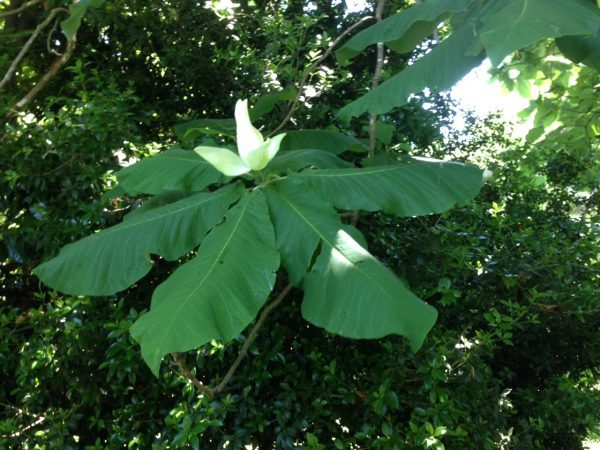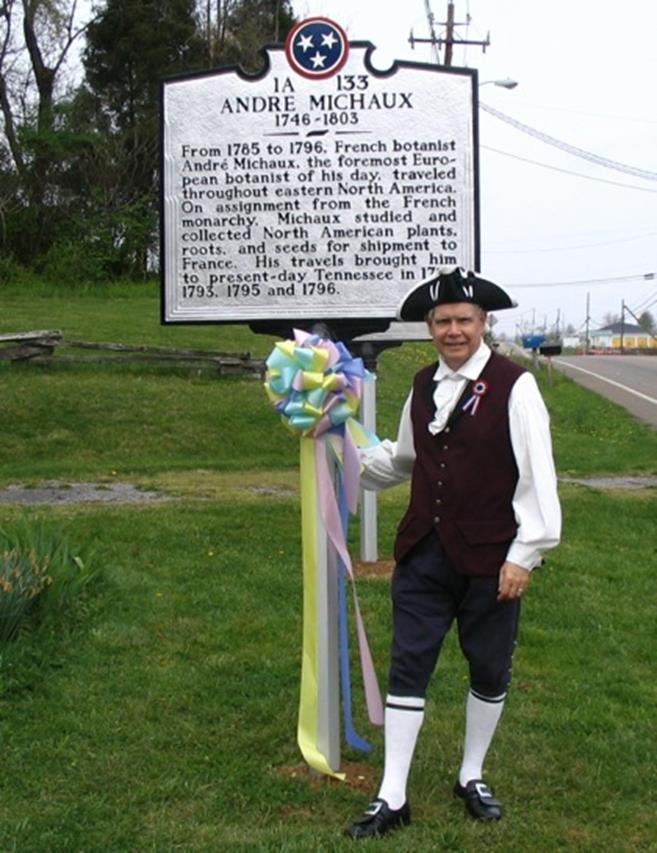Curiosity, coincidence led to rediscovery of Gaston magnolia

The following is excerpted, with permission, from Margins of a Greater Wildness: Nature Essays on Stanley Creek and Beyond, a collection of essays by Richard Rankin on local topics from the Stanley Creek community in eastern Gaston County, where the Rankin family has lived for many generations.
One person is primarily responsible for the rediscovery of bigleaf magnolia (Magnolia macrophylla) in eastern Gaston County. Charlie Williams’ quest to recover the location and the history of this signature species became a grand obsession. Throw in a pinch of serendipity and a dash of relentless curiosity, and the result was the amazing rediscovery of the tree with the largest leaf and flower in North America.
Although common west of the Appalachians in parts of the Mississippi River Valley, bigleaf magnolia is extremely rare in the east and confined mainly to a small pocket of habitat in Gaston County and adjoining York County, S.C. The center of the eastern bigleaf population is Stanley, in Gaston County. Growing in the understory of wooded ravines and associated creeks, the deciduous, hardwood tree with its huge, beautiful leaves and flowers is locally abundant.
André Michaux (1746-1802), the Frenchman who discovered Magnolia macrophylla, was a major figure in American and international botany and horticulture in the late 18th century. French King Louis XVI appointed him royal botanist shortly before the 39-year-old French scientist came to the United States in 1785. In this country he established a plant nursery in Charleston and traveled throughout much of the new nation searching for interesting plants.
On his way from Charleston to the N.C. mountains, Michaux traveled at least five times through what is present-day Gaston County, which gave him the opportunity to discover the bigleaf magnolia.
Charlie Williams, who lives in Charlotte and worked at the Charlotte Mecklenburg Library from the early 1970s until retiring in 2005, developed an interest in André Michaux. This was long before his search for big leaf magnolia began.
But in 1994, Williams was introduced to the special tree through his involvement in Mecklenburg County’s treasure tree program. That year, William S. “Bill” Logan (chairman of Charlotte’s Treasure Tree Program) devised the idea of presenting a program on Magnolia macrophylla at Charlotte’s Arbor Day luncheon as a way of promoting the work of the treasure tree program. Logan enlisted Williams’ help. In May 1995, Williams and Logan visited Fourth Creek in Statesville to see their first bigleaf magnolia in the wild.
As part of his growing interest in bigleaf, Charlie Williams read carefully André Michaux’s journals and North American Sylva, a later publication by Michaux’s son François. Doing so, Williams became convinced Michaux had discovered bigleaf magnolia in what today is eastern Gaston County. That conclusion contradicted the prevailing opinion of Henry Savage Jr., whose highly respected 1986 book on Michaux claimed the French plantsman discovered bigleaf west of the Appalachians in Tennessee, in the heart of the tree’s main range.
Savage and other historians had been misled about the original location because Michaux himself mistakenly used the wrong name, Magnolia cordata (commonly called the yellow cucumber tree), in comparing the new species to another magnolia that William Bartram had found earlier in the mountains. In North American Sylva, François Michaux is clear that he and his father first spotted Magnolia macrophylla in old Lincoln County (present-day eastern Gaston County). André Michaux, however, confounded succeeding generations of historians because of his erroneous reference to another variety of magnolia.
By summer 1995, Charlie Williams was committed to proving the local discovery of bigleaf magnolia. Some of the evidence he found was so strangely serendipitous that it is hard to explain.
In his journals, Michaux mentioned staying with Christian Reinhardt when he was in Lincoln County. Williams had a neighbor in Charlotte on Bertonley Avenue named Philecta Reinhardt. When he asked if she had ever heard of or was related to Christian Reinhardt, she amazingly answered “yes” and directed Charlie to another of his own acquaintances, Edgar Love III, who was her cousin, the family historian, and a prominent Charlotte attorney.
As it turned out, Edgar Love III was not only descended from Christian Reinhardt, but also from Peter Smith, another of Michaux’s Lincoln County hosts in the 18th century. Moreover, Edgar’s father (Edgar “Cap” Love Jr.) owned and lived at Magnolia Grove, between Stanley and Lincolnton, built by Peter Smith’s son David Smith around 1824 and named for the bigleaf magnolias still growing on its grounds. André Michaux, in his journal entries, mentions only four local individuals living between Charlotte and Lincolnton. Edgar Love III was descended from two of them and knew much about their history and land ownership. Charlie Williams’ research was beginning to have a strange air of destiny about it.
Finally, to learn more of the story, Charlie Williams had to hike into the woods. His guide was Jack Moore, a retired Stanley businessman and local amateur historian. In summer 1995, Moore took Williams to one of the many properties he owned around Stanley – this one on Little Hoyle Creek. Williams had already deduced from Michaux’s journal and old land deeds that Michaux collected bigleaf magnolia somewhere along Hoyle Creek and Little Hoyle Creek on land belonging to Peter Smith. When Moore showed Williams where the old Tuckaseegee Road had once come through the property, all the pieces of evidence fit neatly at last. Surrounded by a grove of bigleaf magnolia, Charlie Williams was standing on the land that once belonged to Peter Smith. This was the road Michaux traveled in 1796. This was the place where the French plantsman had collected Magnolia macrophylla to be sent to Charleston.
Charlie Williams’ field research not only recovered Michaux’s history in the area, it also turned up a number of new bigleaf magnolia sites. Before Williams’ field investigations, the North Carolina Natural Heritage Program had identified only 11 bigleaf magnolia populations in the state. With the help of UNC Charlotte biology professors and plant conservationists Jim Matthews and Larry Mellichamp, Charlie Williams located another 11 stands in the vicinity of Stanley. In August 1996, my young son, Isaac, and I were fortunate enough to take Williams to one of these previously unidentified bigleaf sites outside Stanley in a lush gorge on the Estelle Rankin Heirs property.
The rediscovery of bigleaf magnolia and André Michaux’s role has highlighted one of Gaston County’s most captivating plants and its famous discoverer. If you have never entered a grove of bigleaf magnolia in one of its native ravines near Stanley, the Catawba Lands Conservancy regularly offers hikes into such places. These include one of the original Michaux sites. In 2006, largely as a result of Charlie Williams’ urging, Jack Moore and his family created a permanent nature preserve of 100 acres on Hoyle Creek at its junction with Little Hoyle Creek. That was where Michaux originally gathered Magnolia macrophylla for his Charleston nursery. The Moores donated part and sold part of this land to the Catawba Lands Conservancy.
We have Charlie Williams and his friends to thank for re-discovering bigleaf magnolia and publicizing its story. Williams would simply describe it as a great adventure which he has enjoyed immensely.
Richard Rankin is headmaster at Gaston Day School, as well as a historian, conservationist and native of Gaston County and Stanley Creek.